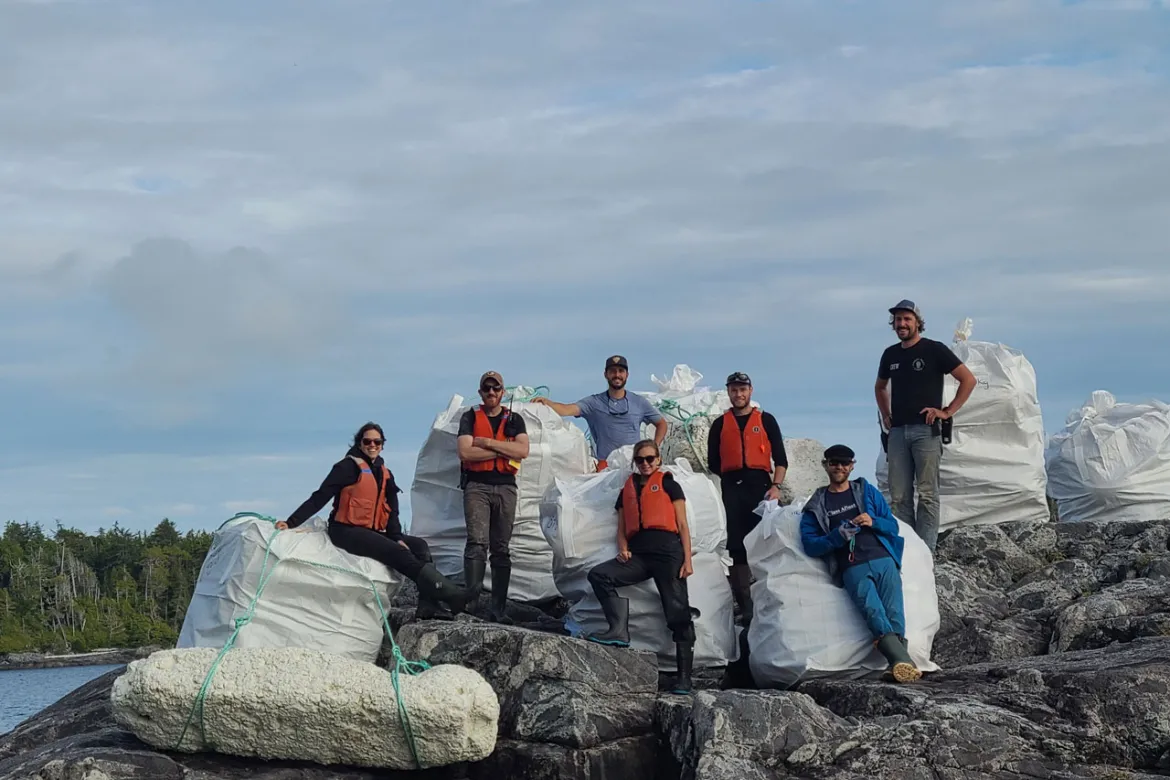Marine Debris Removal Initiative – A Good News Story?

When our 2020 tour season began crumbling away in May, a group of ecotour operators, including Bluewater Adventures started talking about what alternate options are open to us should our season be put on pause. We have capable boats that are self-sufficient for weeks and an incredible crew, experienced at operating in some of the most demanding and exposed areas of the British Columbia coast.
We knew that coastal First Nations wanted to keep visitors far away from their home villages to keep their communities safe during these times of COVID. So, what about collecting marine plastic and debris from the outer islands of the Great Bear Rainforest?
Thus, began the Marine Debris Removal Initiative – a “great collaboration”. Working closely with coastal First Nations, we developed a plan for two, 21-day expeditions. It included 9 vessels and 100 crew to navigate the rough and rocky islands to collect the debris by hand and package it in 300lb helicopter lift bags.
The helicopter long-lines it to a First Nations-owned tug boat and barge for transport and disposal at 7-Mile near Port McNeill on Vancouver Island. While we estimated that we would encounter between 50 and 100 tonnes of debris, by September 28 we had removed 127 tonnes of old fishing gear, Styrofoam and thousands of single use water bottles – far beyond our wildest (and worst) dreams. .
Learn More - “Range Rover: Waste Not, Want Not”, by Leslie Anthony
https://www.piquenewsmagazine.com/opinion/waste-not-want-not-2890494
 |
 |
|
 Photos: Eddy Savage Photos: Eddy Savage |
What was it really like? Anecdotes from a Skipper:
- A skipper on the second expedition said over the radio “we should have this island cleaned up in 2 hours”. Three days later they had taken 3.5 tonnes off that one small island. The theme was repeated again and again…
- Island Odyssey’s largest day was 7 lift bags and 1875 kg (4100 pounds). Island Roamer had a 2000 kg day when they found a giant trawler net that took them more than a day to cut up and package for lifting.
- By late-September with crews finely tuned, we were collecting 10 tonnes a day. We ended up running out of barge space and were forced to stop.
- One very disturbing discovery – Styrofoam that had broken down into tiny pellets forming “middens” that went 4-6 feet deep into the forest and lined the shoreline! Shrouded by overhanging salal and mosses, these little toxic spheres will be washed back into the sea with the next winter storm, likely to be mistaken for food by marine life and sea birds. This stuff does not degrade or decompose – it's there forever.
- It would have taken days just to pick up all the tiny pieces of debris we encountered. We couldn’t pick up all the debris we found so had to choose to get the maximum amount off the coast we could. We had to make the decision to maximize the amount of plastic we could collect to prevent it from returning to the ocean to break down further into micro plastics.
- One of the boats went out to an outer island. They filled four 700 pound lift bags from just 15 m of shore and were forced to give up. We were learning that there was more debris on our coast that this initiative could conceivably remove in the time allotted.
- We wanted to come back and say we had cleaned the entire outer central coast. We did cover over 1000 km, but all too often reality interfered. Island Odyssey spent 7-days cleaning 4 km of coast on the second expedition. And there is so much more out there...
Header image: Eddy Savage


